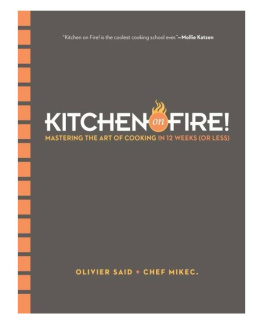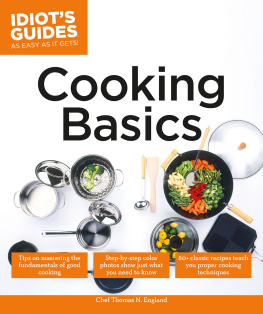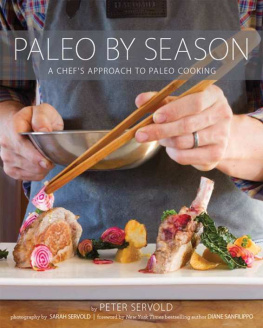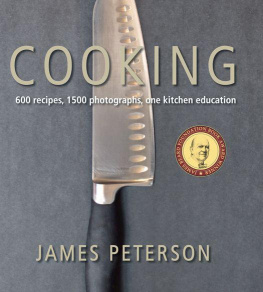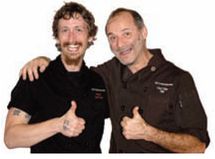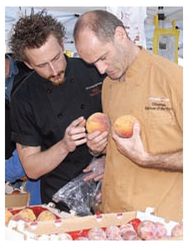ACKNOWLEDGMENTS
WE WOULD FIRST LIKE TO THANK ALL THE PEOPLE WHO HAVE HELPED us building and running Kitchen on Fire over the years. Without a little help form our friends, the journey wouldnt have been such a fun and exciting experience. Also a big debit of gratitude to all of our students and clients in our hometown of Berkeley and all over the greater San Francisco Bay Area; your support helps not only Kitchen on Fire thrive, but enables us to help our charitable non-profit friends at St. Vincent de Paul of Alamedas Kitchen of Champion program, The Pacific Coast Farmers Market Associations Cooking Matters program, and the Hercules High School Culinary Academy.
A special thanks to our staff for keeping us motivated, organized, and their passion for what Kitchen on Fire is all about: our super sous chef Gilad Chudler, culinary manager Carol Davison, business manager Erin Griffin, fantastic bookkeeper Susan Wendt-Bogear, and the dynamic dishland duo of John Stovall and Jesse Meth. To all our apprentices for being such awesome people and teaching us as much as we teach them, we thank you.
Thanks also to Lyla Foggia, Jean Pierre Moull, Bonnie Solow, Gus Walbolt, Soheyl Modarressi, Joanne Weir, and Richard Chapman for being friends, mentors, and advisors to these two wacky chefs. A big thank you to Steve Kimbrough and Marie Teixeira for all of their technical expertise, encouragement, and friendship over the years.
We would like to thank our literary agent Steve Troha at Folio Literary Management for being a great guy and his faith in us and the book. Also thank you to Mollie Katzen for introducing us to Steve, and for being an inspiration to cookbook authors and cooks everywhere. A huge thank you to Renee Sedliar, Lisa Diercks, Cisca Schreefel, and the entire team at our publisher Da Capo Press for helping us make this book a reality. Also thanks to Julia Przemyslaw and Kyle Ford for helping with long photo shoot sessions.
Of course a shout out and big thanks to our sponsors and industry friends for their support and belief; especially Mark Henry for his awesome Furitechnics kitchen knives and sharpeners, Cathleen Mandigo, Suzanne Murphy, and the entire team at Meyer Corporation for their fantastic Anolon and Circulon cookware and tools, and Chelcea Dressler and everyone at Messermeister for their great kitchen knives and tools. And a special thanks to Dan Austin and the team at Rocket Restaurant Resource for their help with building Kitchen on Fires second location.
Olive would especially and personally thank absolutely everybody, in case he forgot somebody.
MikeC. would like to personally thank his friends and family, especially Ann Moss, for their encouragement and undying support all these years.
METRIC CONVERSIONS
The recipes in this book have not been tested with metric measurements, so some variations might occur. Remember that the weight of dry ingredients varies according to the volume or density factor: 1 cup of flour weighs far less than 1 cup of sugar, and 1 tablespoon doesnt necessarily hold 3 teaspoons.
GENERAL FORMULA FOR METRIC CONVERSION
| Ounces to grams | multiply ounces by 28.35 |
| Grams to ounces | multiply ounces by 0.035 |
| Pounds to grams | multiply pounds by 453.5 |
| Pounds to kilograms | multiply pounds by 0.45 |
| Cups to liters | multiply cups by 0.24 |
| Fahrenheit to Celsius | subtract 32 from Fahrenheit temperature, multiply by 5, divide by 9 |
| Celsius to Fahrenheit | multiply Celsius temperature by 9, divide by 5, add 32 |
VOLUME (LIQUID) MEASUREMENTS
| 1 teaspoon | = fluid ounce | = 5 milliliters |
| 1 tablespoon | = fluid ounce | = 15 milliliters |
| 2 tablespoons | = 1 fluid ounce | = 30 milliliters |
| cup | = 2 fluid ounces | = 60 milliliters |
| cup | = 2 fluid ounces | = 79 milliliters |
| cup | = 4 fluid ounces | = 118 milliliters |
| 1 cup or pint | = 8 fluid ounces | = 250 milliliters |
| 2 cups or 1 pint | = 16 fluid ounces | = 500 milliliters |
| 4 cups or 1 quart | = 32 fluid ounces | = 1,000 milliliters |
| 1 gallon | = 4 liters |
WEIGHT (MASS) MEASUREMENTS
| 1 ounce | = 30 grams |
| 2 ounces | = 55 grams |
| 3 ounces | = 85 grams |
| 4 ounces | = pound | = 125 grams |
| 8 ounces | = pound | = 240 grams |
| 12 ounces | = pound | = 375 grams |
| 16 ounces | = 1 pound | = 454 grams |
OVEN TEMPERATURE EQUIVALENTS, FAHRENHEIT (F) AND CELSIUS (C)
| 100F | = | 38C |
| 200F | = | 95C |
| 250F | = | 120C |
| 300F | = | 150C |
| 350F | = | 180C |
| 400F | = | 205C |
| 450F | = | 230 C |
VOLUME (DRY) MEASUREMENTS
| teaspoon | = | 1 milliliter |
| teaspoon | = | 2 milliliters |
| teaspoon | = | 4 milliliters |
| 1 teaspoon | = | 5 milliliters |
| 1 tablespoon | = | 15 milliliters |
| cup | = | 59 milliliters |
| cup | = | 79 milliliters |
| cup | = | 118 milliliters |
| cup | = | 158 milliliters |
| cup | = | 177 milliliters |
| 1 cup | = | 225 milliliters |
| 4 cups or 1 quart | = | 1 liter |
| gallon | = | 2 liters |
| 1 gallon | = | 4 liters |
LINEAR MEASUREMENTS
| in | = | 1 cm |
| 1 inch | = | 2 cm |
| 6 inches | = | 15 cm |
| 8 inches | = | 20 cm |
| 10 inches | = | 25 cm |
| 12 inches | = | 30 cm |
| 20 inches | = | 50 cm |
RESOURCES
Corriher, Shirley O. Cookwise: The Hows and Whys of Successful Cooking. New York: HarperCollins Publlishers Inc., 1997
McGee, Harlod. On Food and Cooking: The Science and Lore of the Kitchen, 2nd ed. New York: Charles Scribners Sons, 2004
This, Herv, MolecularGastronomy: Exploring the Science of Flavor. trans. Malcolm DeBevoise. New York: Columbia University Press, 2006
Wolke, Robert L. What Einstein Told His Cook. New York: W.W. Norton & Company, Inc., 2002
. What Einstein Told His Cook 2. New York: W.W. Norton & Company, Inc., 2005
WEEK 1
KNIFE SKILLS AND MISE EN PLACE
MASTERING THE ART OF KNIFE SKILLS IS THE FIRST AND ONE OF THE most important parts of the entire cooking process. If food is not cut correctly, it will not cook correctly, plain and simple. No other skill taught in this book will have such a dramatic effect on your overall cooking abilities as will honing the craft of expertly wielding your knives. The becoming-an-expert part comes with some time and practice. The key is to make sure to start off slowly until the motions feel comfortable and natural to you; then, increase your speed a bit. It doesnt happen overnight; retraining your muscles to move in a new way after years of improperly using a knife takes focus. The best part is, you get to practice every time you cook.

